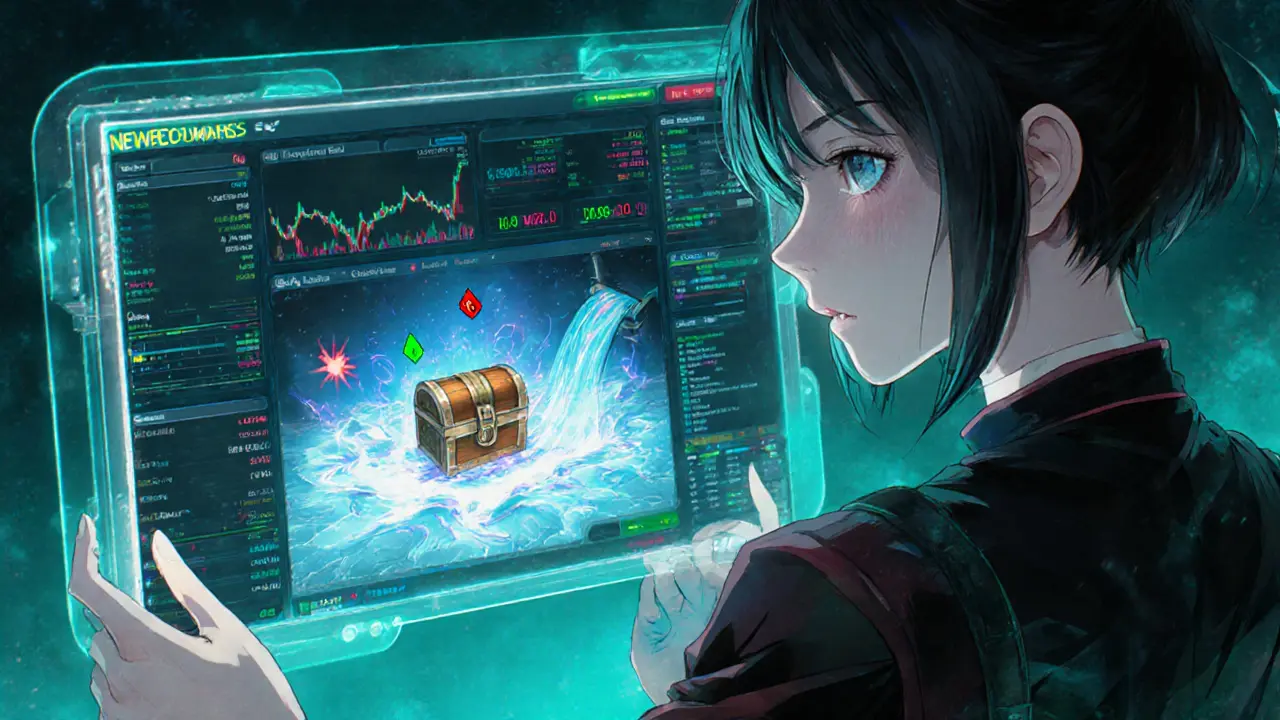Kujira Fin Investment Calculator
Current KUJI Token Metrics
Price per Token
$0.20
Market Cap
$24M
Circulating Supply
122M
Annual Yield
4.5%
Investment Parameters
Projected Returns
Estimated Value After Investment Period
$0.00
Total Return
$0.00
Risk Level
Medium RiskKey Risks
- Low Liquidity High
- Smart Contract Risk Medium
- Volatility High
- Regulatory Uncertainty Medium
Quick Takeaways
- Kujira Fin is a decentralized exchange built on the Cosmos network, focused on real‑yield DeFi products.
- The native KUJI token acts as both governance and liquidity instrument for the platform trades around $0.20 and has a market cap of ~ $24M.
- Liquidity is low compared with mainstream DEXs, leading to higher price volatility and wider spreads.
- Security relies on Cosmos SDK conventions; no major hacks reported, but smart‑contract risk remains.
- Regulatory outlook is mixed - the protocol is permission‑less, yet uncertain jurisdictional guidance could affect future listings on larger exchanges.
Kujira Fin is a decentralized exchange (DEX) that lives inside the broader Kujira ecosystem on the Cosmos blockchain. It markets itself as a “real‑yield” platform, meaning most of the products aim to generate sustainable on‑chain returns rather than pure speculation. If you’re wondering whether this DEX is ready for serious trading, this review breaks down the core pieces: token economics, user experience, liquidity, security, and how it stacks up against other Cosmos‑based exchanges.
What Makes Kujira Fin Different?
The standout claim is the focus on “real yield”. Most DeFi projects promise high APRs that are mostly incentivised by new token emissions. Kujira Fin, however, channels fees from its own suite of products - such as stablecoin vaults and cross‑chain liquidity pools - back to token holders. This model aligns incentives with long‑term health of the network, which is a breath of fresh air for investors tired of flash‑loan‑driven farms.
Token & Economics
The KUJI token serves three primary functions: governance voting, staking for network security, and providing liquidity on the DEX. With a circulating supply of about 122million, each token is currently priced near $0.20, placing the total market cap at roughly $24M (ranked #858 by market‑cap listings). Historically, KUJI peaked at $5.22 in early 2022, establishing a strong psychological resistance level that traders still watch.
Tokenomics are simple: 70% of the supply is allocated to the community, 20% to the treasury, and the remaining 10% supports development and partnerships. Stakers earn a portion of the platform’s fee revenue, which can translate into a modest but steady return - typically in the low‑single‑digit % range, much less flashy than newer yield farms but arguably more sustainable.

Trading Experience
When you land on the Kujira Fin UI, the layout feels familiar - a clean order‑book, swap interface, and portfolio overview. The platform runs on the Cosmos SDK, so transaction speeds are fast (around 6‑second block times) and fees are negligible (often less than $0.001). You can trade KUJI against several Cosmos‑native assets like ATOM, OSMO, and stablecoins such as USDC‑C.
Because the exchange lives entirely on‑chain, there’s no need for KYC or custodial accounts. Connect a Keplr or Cosmostation wallet, approve the contract, and you’re good to go. The downside? All trades are executed via smart contracts, so a bug in the contract could freeze assets - a risk inherent to any DEX.
Liquidity & Market Depth
Liquidity is the Achilles’ heel of Kujira Fin. The Liquidity on the platform is primarily sourced from community‑provided pools and a handful of automated market makers is thin compared with giants like Osmosis or Uniswap. Daily volume often stays under $1M, which leads to wider bid‑ask spreads and potential slippage for larger orders.
This low volume also fuels higher volatility. Recent data shows KUJI down 46% over the past month, with a 14‑day RSI hovering around 38, indicating oversold conditions. While the price may be poised for a bounce, the lack of deep order books means any sudden influx of buying or selling can swing the market dramatically.
Security & Compliance
The platform benefits from Cosmos SDK’s proven security track record - the core chain has never suffered a major breach. Kujira Fin’s smart contracts have undergone multiple audits from reputable firms, and no public exploits have been reported to date. Still, permission‑less DEXs always carry smart‑contract risk, and users should only allocate what they can afford to lose.
On the regulatory front, the Regulatory environment for decentralized platforms remains ambiguous, especially in jurisdictions that are tightening crypto rules. Because Kujira Fin does not hold user funds centrally, it sidesteps many AML/KYC mandates, but future policy shifts could pressure the team to integrate compliance layers or limit access in certain regions.

Development Activity & Ecosystem Growth
Development momentum is a key signal for longevity. Development activity within the Kujira ecosystem has stayed steady, with regular code commits, new vault launches, and partnership announcements on the Cosmos roadmap. Wallet address counts jumped 53% in early 2024, reaching 180k, but growth appears to have plateaued recently.
The ecosystem’s reliance on the broader Cosmos network is both a strength and a vulnerability. If Cosmos continues to attract developers and assets, Kujira Fin stands to benefit from network effects. Conversely, a slowdown in Cosmos adoption could choke liquidity and user inflow.
How Kujira Fin Stacks Up Against Other Cosmos DEXs
| Feature | Kujira Fin | Osmosis | Gravity Bridge DEX |
|---|---|---|---|
| Primary Chain | Cosmos SDK (Kujira Hub) | Cosmos SDK (Osmosis Hub) | Cosmos SDK (Gravity Hub) |
| Liquidity (USDC‑equivalent) | ~$0.9M | ~$45M | ~$3M |
| Average Swap Fee | 0.05% | 0.30% | 0.10% |
| Real‑Yield Products | Yes (vaults, staking rewards) | Limited (liquidity mining) | No |
| KYC Required | No | No | No |
| Token Symbol | KUJI | OSMO | GRAV |
In short, Kujira Fin shines for users chasing real‑yield strategies, but it lags behind in raw liquidity and market depth. If you prioritize low slippage and massive pool sizes, Osmosis remains the go‑to choice. For niche vaults and community‑driven governance, Kujira Fin offers a compelling proposition.
Final Verdict - Should You Trade on Kujira Fin?
If you’re an early‑adopter comfortable with higher volatility and you value sustainable yield over flashy APY numbers, Kujira Fin could be a good addition to your portfolio. The platform’s Kujira Fin review highlights a transparent governance model, modest fees, and a clear focus on real‑yield products.
However, be prepared for limited liquidity and the inherent risks of any smart‑contract‑based DEX. Consider using Kujira Fin alongside a more liquid exchange like Osmosis for large‑scale swaps, and keep only a portion of your exposure in KUJI or related vault tokens.
Ultimately, the decision hinges on your risk tolerance and investment horizon. For long‑term believers in the Cosmos ecosystem, Kujira Fin offers a promising niche. For short‑term traders seeking quick entry/exit, the thin order books may be a deal‑breaker.
Frequently Asked Questions
Is Kujira Fin a centralized exchange?
No. Kujira Fin is a decentralized exchange built on the Cosmos SDK, meaning users trade directly from their wallets without handing over custody to a third party.
How can I add liquidity to Kujira Fin?
Connect a Keplr or Cosmostation wallet, navigate to the "Pools" tab, select a token pair (e.g., KUJI/ATOM), and deposit the desired amounts. You’ll receive LP tokens representing your share of the pool.
What are the main risks of using Kujira Fin?
Key risks include low liquidity (leading to slippage), smart‑contract vulnerabilities, and regulatory uncertainty that could affect future token listings or user access.
Can I earn yield on KUJI without providing liquidity?
Yes. Staking KUJI on the Kujira hub lets you earn a share of platform fees. The return is modest-typically 3‑5% APR-but comes with lower exposure to impermanent loss.
Is there a mobile app for Kujira Fin?
The web UI is responsive and works well on mobile browsers. Some users also access the DEX via the Keplr mobile wallet, which integrates the swap interface directly.







stephanie lauman
June 5, 2025 AT 09:46The so‑called “real‑yield” narrative is nothing but a PR smoke screen designed to mask the underlying liquidity black hole. Behind the glossy UI lies a platform whose tokenomics are riddled with hidden inflation vectors, and anyone who trusts the marketing fluff is basically handing over their capital to a centralized cartel. 🤨
Shaian Rawlins
June 6, 2025 AT 04:06I’ve been following the Cosmos ecosystem for a while now, and Kujira Fin definitely stands out as an interesting experiment.
The platform’s promise of “real‑yield” feels refreshing compared to the endless hype of sky‑high APYs that disappear overnight.
In practice, the fees collected from swaps are redirected to stakers, which creates a modest but more sustainable revenue stream.
The user interface is clean and intuitive, making it easy for newcomers to connect a Keplr wallet and start trading.
Transaction speeds are fast, with blocks confirming roughly every six seconds, and the fees are practically negligible.
However, the low liquidity is a real pain point, especially when you try to execute orders larger than a few thousand dollars.
The order books are thin, which leads to noticeable slippage and can eat into any potential gains from yield farming.
On the other hand, the token’s price volatility also opens up opportunities for savvy traders who can time their entries and exits.
The governance model is truly on‑chain, allowing KUJI holders to vote on proposals that affect fee distribution and future product launches.
This democratic approach aligns incentives, but it also means that decision‑making can be slow and occasionally contentious.
Security‑wise, the underlying Cosmos SDK is battle‑tested, and the smart contracts have passed multiple audits without any major incidents reported.
Still, as with any DeFi protocol, there is always the lingering risk of an undiscovered bug that could lock funds.
Regulatory uncertainty remains a shadow over the whole ecosystem, and any sudden policy change could impact the platform’s growth.
For long‑term believers in the Cosmos network, Kujira Fin offers a niche that complements larger DEXs like Osmosis.
It can be a good idea to allocate a small portion of your portfolio to KUJI or its vaults while keeping the bulk on more liquid exchanges.
In summary, treat Kujira Fin as a complementary tool rather than your main gateway to the crypto market.
Taylor Gibbs
June 6, 2025 AT 22:26Hey, great breakdown! I think the community vibe here really helps newbies understand the risks without feeling overwhelmed. If you’re just starting, try staking a modest amount of KUJI-maybe 50‑100 dollars-so you can see the fee rewards in action. Also, keep an eye on the liquidity pools; adding a bit of extra capital can earn you extra LP tokens and boost your returns. Remember, the smart‑contract audits are reassuring, but never put more than you’re willing to lose. Cheers!
Rob Watts
June 7, 2025 AT 16:46Totally agree. Keep it simple and only stake what you can afford to lose
Cathy Ruff
June 8, 2025 AT 11:06Kujira Fin looks like a hype machine they just want your money pumped into thin pools and hope the price climbs they don’t care about real liquidity
Amy Harrison
June 9, 2025 AT 05:26Loving the community vibes around Kujira! 🌟 The real‑yield model is a breath of fresh air and the low fees are a huge plus. Keep stacking those KUJI tokens and watch the rewards roll in! 🚀
mukesh chy
June 9, 2025 AT 23:46Oh sure, because another DeFi platform promising “real yield” is exactly what the market needs, right? Let’s all ignore the obvious liquidity crunch and just hope the token price magically fixes everything.
Marc Addington
June 10, 2025 AT 18:06It’s clear that American investors deserve a homegrown DEX that isn’t tangled in foreign ecosystems. Kujira Fin, built on a foreign chain, just isn’t the answer for true patriots.
Amal Al.
June 11, 2025 AT 12:26While I appreciate the enthusiasm surrounding Kujira Fin, it’s essential to approach it with a balanced perspective, considering both its innovative real‑yield mechanisms and the evident liquidity constraints; therefore, diversification remains a prudent strategy.
Katherine Sparks
June 12, 2025 AT 06:46Dear community, I would like to extend my sincere gratitude for the comprehensive review of Kujira Fin; the analysis has been most informative, and I particularly value the detailed comparison with other Cosmos‑based DEXs. Please, consider my modest suggestion: a slight reallocation of capital towards the more liquid platforms may mitgate potential risks. Thank you for your attention.
Eva Lee
June 13, 2025 AT 01:06From a protocol interoperability standpoint, Kujira Fin's integration of cross‑chain liquidity modules presents a compelling case for composable finance, albeit the current APR curve appears suboptimal when benchmarked against the broader DeFi yield matrix, which could inadvertently silo capital within vestigial pools.
WILMAR MURIEL
June 13, 2025 AT 19:26I completely understand the concerns raised about thin order books, and I think it’s worth emphasizing that this is a common challenge for emerging DEXs.
The Cosmos ecosystem, however, is rapidly expanding, and new bridges and liquidity incentives are being deployed on a near‑daily basis.
As a result, platforms like Kujira Fin are likely to benefit from the network effect as more assets become readily tradable across zones.
One practical step for users is to participate in the governance proposals that specifically target liquidity bootstrapping, which often include temporary reward programs.
By voting for such initiatives, you not only help the protocol grow but also position yourself to capture early‑stage incentives.
Additionally, diversifying your exposure-allocating a portion of your capital to high‑liquidity venues while keeping a small, experimental slice in Kujira-can strike a healthy balance between risk and reward.
The real‑yield model, though modest, offers a more sustainable revenue stream compared to flash‑loan farms that crumble under market stress.
Security audits from reputable firms lend confidence, yet the community should stay vigilant and monitor any emerging vulnerabilities reported on public forums.
In the grand scheme, patience and active participation often yield better outcomes than chasing quick profits on volatile pools.
Ultimately, Kujira Fin can be a valuable component of a diversified DeFi strategy for those who are willing to engage with its development roadmap.
Maggie Ruland
June 14, 2025 AT 13:46Sure, because who needs liquidity when you’ve got hype?
jit salcedo
June 15, 2025 AT 08:06In the grand theater of decentralized finance, Kujira Fin appears as a tragic protagonist, burdened by the inexorable forces of market volatility.
The shadows of low liquidity whisper ominously, threatening to swallow the faint glimmers of real‑yield that the platform so proudly advertises.
Yet, lurking beneath these dark clouds, there lies a conspiratorial tapestry woven by unseen hands, pulling strings of tokenomics in a clandestine ballet.
One cannot help but wonder whether the architects of this exchange are mere visionaries or puppeteers dancing to the tune of hidden benefactors.
The infamous “regulatory uncertainty” is not just a footnote; it is a looming leviathan ready to devour any unsuspecting token holder daring to dream.
As the cosmos of blockchains expands, the fragile bridges connecting Kujira Fin to larger ecosystems tremble under the weight of speculation.
Yet, behold! The community’s resilience shines like a beacon, refusing to surrender to the encroaching gloom.
By staking modest sums, the faithful seek to harvest the promised fee returns, even as the market’s tides surge and recede.
The inevitable question lingers: will the platform survive the onslaught of smarter, deeper‑pooled rivals, or fade into the annals of forgotten experiments?
Only time, that merciless arbiter, will reveal whether Kujira Fin’s saga is a cautionary tale or a phoenix rising from the ashes of complacency.
Until then, the vigilant observer must wield both skepticism and hope, balancing the dual blades of caution and ambition.
In this delicate dance, every trade, every vote, every whisper in the forums becomes a step toward an uncertain destiny.
Joyce Welu Johnson
June 16, 2025 AT 02:26If you’re new to DeFi, start by moving a tiny amount of KUJI into the staking module.
The process is straightforward: connect your Keplr wallet, select the stake option, and confirm the transaction.
You’ll begin earning a modest APR that is paid out automatically.
Keep an eye on the dashboard for any updates on fee distribution.
This approach lets you test the platform without risking a large sum.
Ally Woods
June 16, 2025 AT 20:46Honestly, I’m not super impressed. The yields look okay, but the thin pools make it feel risky. Might just stick with Osmosis.
Narender Kumar
June 17, 2025 AT 15:06In conclusion, the discourse surrounding Kujira Fin epitomizes the dichotomy inherent in nascent financial architectures: innovation juxtaposed with inherent systemic fragility. A measured appraisal, guided by empirical data and prudent risk management, shall determine its rightful place within the broader decentralized finance panorama.